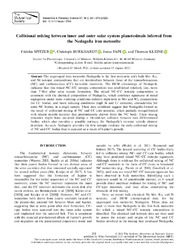Collisional mixing between inner and outer solar system planetesimals inferred from the Nedagolla iron meteorite
DOI: https://doi.org/10.1111/maps.13744
Persistent URL: http://resolver.sub.uni-goettingen.de/purl?gldocs-11858/10050
Persistent URL: http://resolver.sub.uni-goettingen.de/purl?gldocs-11858/10050
Spitzer, Fridolin; Burkhardt, Christoph; Pape, Jonas; Kleine, Thorsten, 2021: Collisional mixing between inner and outer solar system planetesimals inferred from the Nedagolla iron meteorite. In: Meteoritics & Planetary Science, Band 57, 2: 261 - 276, DOI: 10.1111/maps.13744.
 |
Dokument öffnen: |
The ungrouped iron meteorite Nedagolla is the first meteorite with bulk Mo, Ru, and Ni isotopic compositions that are intermediate between those of the noncarbonaceous (NC) and carbonaceous (CC) meteorite reservoirs. The Hf‐W chronology of Nedagolla indicates that this mixed NC–CC isotopic composition was established relatively late, more than 7 Myr after solar system formation. The mixed NC–CC isotopic composition is consistent with the chemical composition of Nedagolla, which combines signatures of metal segregation under more oxidizing conditions (relative depletions in Mo and W), characteristic for CC bodies, and more reducing conditions (high Si and Cr contents), characteristic for some NC bodies, in a single sample. These data combined suggest that Nedagolla formed as the result of collisional mixing of NC and CC core material, which partially re‐equilibrated with silicate mantle material that predominantly derives from the NC body. These mixing processes might have occurred during a hit‐and‐run collision between two differentiated bodies, which also provides a possible pathway for Nedagolla's extreme volatile element depletion. As such, Nedagolla provides the first isotopic evidence for early collisional mixing of NC and CC bodies that is expected as a result of Jupiter's growth.
Statistik:
ZugriffsstatistikSammlung:
This is an open access article under the terms of the Creative Commons Attribution‐NonCommercial License, which permits use, distribution and reproduction in any medium, provided the original work is properly cited and is not used for commercial purposes.

